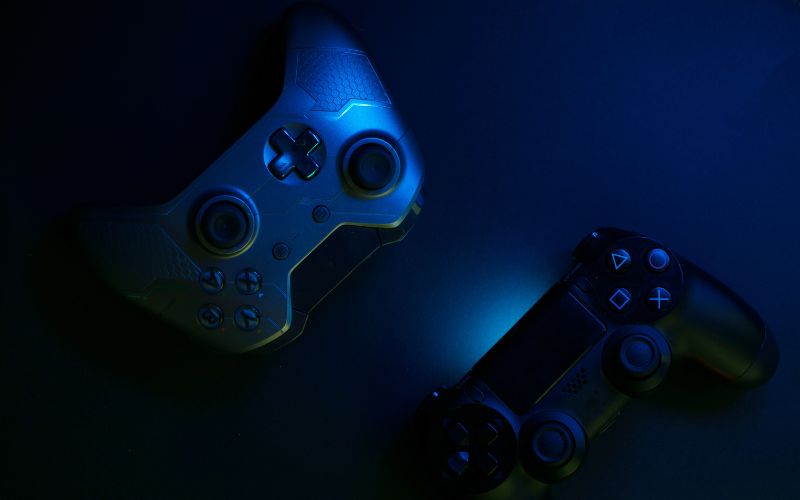Have you ever wished to design a game where players venture through neon-lit worlds on other planets or drive through cities that seem to have life? That wish is now closer than ever, with next-gen hardware!
For Indian students interested in game development, this is the moment. Emerging technology is changing the way games are created, making them more real and exciting.
This blog discusses how next-gen hardware and game design are coming together to create the future. Let’s enter this incredible future of gaming technology!
What is Next-Gen Hardware?
Next-gen hardware is the newest technology employed in gaming equipment. Consider high-powered consoles such as the PlayStation 5, the Xbox Series X, or top-of-the-line PCs. These devices have quicker processors, improved graphics cards, and increased memory. They also encompass smartphones with improved chips.
Mobile gaming hardware in 2025 will process complex graphics, with 3.32 billion gamers across the globe playing them. Next-gen hardware is similar to an ultra-powerful engine that drives amazing games.
Why is Hardware Important to Game Design?
Game designers come up with the concepts, narratives, and graphics for games. Hardware brings ideas to life. More powerful hardware allows designers to create larger worlds, include realistic touches, and provide silky-smooth gameplay. Without it, games could drag or appear dull.
With most of the gamers now assuming high-quality graphics, hardware is central to satisfying those expectations. It’s like providing artists with a larger canvas and more vivid colours with which to paint!
How Next-Gen Hardware Enhances Game Creation
Next-gen hardware creates new possibilities for game creators. It makes projects more fun and imaginative. Here’s why, in simple terms:
Stunning Visuals
- Make characters that look alive, with expressive faces.
- Create worlds with realistic water or forests.
- Use natural lighting and shadows with ray tracing.
Faster Performance
- Create games that load instantly, not in minutes.
- Handle massive worlds without lag or crashes.
- Maintain smooth gameplay, even with large crowds.
Bigger Game Worlds
- Build gigantic cities or planets to discover.
- Insert thousands of objects, such as trees or crowds.
- Make every nook and cranny of the game come alive.
Smarter AI
- Build enemies that think and act like humans.
- Design NPCs with distinctive behaviours.
- Apply AI to customise the game to each player’s play style.
Immersive Experiences
- Support virtual reality (VR) for 3D adventures.
- Employ haptic feedback for authentic controller vibrations.
- ‘Transport’ players into the game.
These changes allow games to be more enjoyable and also allow game designers to dream bigger.
The Key Technologies Powering Next-Gen Games
Next-generation game systems utilise special technology to allow for amazing games to be developed. Below are the top game development technologies that students should be aware of:
Powerful GPUs
- Graphics processing units produce high-quality visuals.
- They can handle effects like smoke or reflections.
- Arm’s ASR technology significantly boosts mobile GPU performance.
Fast SSDs
- Solid state drives have quickly been developed to load games extremely quickly.
- The waiting time between levels or story chapters is now very minimal.
- These drives are also able to support multiple huge game files to build much larger worlds.
AI and Machine Learning
- Artificial intelligence now allows for evolving dynamic game worlds.
- Machine learning also impacts player experience by adapting the complexity or difficulty.
- It is estimated that AI (and machine learning) is used in almost 40% of the new video games coming to market, making them more intelligent.
Cloud Gaming
- With cloud gaming, users can now ‘stream’ games without the need for a game console or powerful device.
- This means they can have very high-quality mobile games even if they have only a laptop or phone.
- Cloud gaming has only just begun and has an increasing number of users, with 455.38 million predicted in 2025.
VR and AR Hardware
- The gap between VR and AR is almost merged. But virtual reality headsets have contributed to what can now be 3D worlds. It is combined with augmented reality.
- Augmented reality merges games with reality.
- The VR gaming market is expected to reach $45 billion by 2030.
These gadgets are like a superhero’s arsenal, assisting designers in making legendary games.
How Next-Gen Hardware is Used by Game Designers
Hardware is used by game designers to make ideas a reality. This is how they utilise it in 2025:
Planning with Power in Mind
- Design games that leverage hardware’s maximum power.
- Select features such as ray tracing or AI opponents.
- Balance performance and graphics for silky-smooth play.
Creating Detailed Assets
- Create 3D models with software such as Blender or Maya.
- Add texturing for realistic metal or grass.
- Use hardware to render them in real time.
Testing on New Devices
- Try games on mobiles, PCs, or consoles.
- Check if VR controllers or headsets work fine.
- Fix bugs so that it is fun on every platform.
Using Game Engines
- Work with Unreal Engine 5 or Unity for next-gen capabilities.
- Add features like Nanite for realistic landscapes.
- Optimise games for quick load and play.
Collaborating with Teams
- Share ideas with artists and coders.
- Use hardware to try out team designs in a hurry.
- Build games more quickly with live tools.
The process is similar to rocket-building, where each component complements the other for a wonderful blast-off.
Challenges of Next-Gen Game Design
New hardware isn’t always simple to work with. The following are challenges and solutions during game designing:
High Costs
- Challenge: Next-gen devices and tools are expensive.
- Solution: Use free software such as Unity or Figma. Use low-key PCs first and upgrade afterwards.
Learning New Tech
- Challenge: AI or VR software feels complicated.
- Solution: Take YouTube lessons. Practice with small projects to learn.
Meeting Player Expectations
- Challenge: Players expect perfect and captivating games.
- Solution: Playtest games with friends. Make designs better based on feedback.
Team Coordination
- Challenge: Large projects require lots of people.
- Solution: Utilise project tools such as Trello. Talk clearly with teammates.
These obstacles are puzzles. Fixing them makes you a better designer.
Why Next-Gen Hardware Excites Students
Next-gen hardware is a game-changer for Indian students. It turns game design into an exciting career. With the gaming industry in India expanding to $3.9 billion by the end of 2025, jobs are flourishing. Students can design games for the world.
Online classes and free tools make it easy to learn. Hardware allows you to try out wild ideas, such as VR experiences or AI narratives. It is like opening a chest of golden opportunities for your future!
The Future of Game Design with Next-Gen Hardware
The future of game design is bright and bold! Here’s what’s next in 2025 and beyond
- Hyper-Realistic Games: Graphics will look like real life, with detailed worlds.
- AI-Powered Stories: Games will change based on player choices, using AI.
- Cross-Platform Play: Design games for consoles, PCs, and mobiles at once.
- Ethical Gaming: Games will tackle themes like climate change or teamwork.
Apart from video game graphics evolution, these trends make game design an exciting field for students to explore.
Why Join Us at Moople Academy to Learn Game Design?
Moople Academy is the ideal place to begin your game-designing career. Within eighteen months, our course teaches you how to design games.
- You can design with Unity and Blender, software that can work with next-gen hardware.
- You learn how to create characters, construct worlds, and program gameplay from expert instructors.
- Hands-on assignments, such as creating a mobile game, get you ready for actual work.
At Moople, we provide job placement assistance, connecting you with leading game studios. Courses are easy and enjoyable, perfect for Indian students. With Moople, you’ll be set to develop games that sparkle on new hardware. It’s like having a guide to lead you to success.
Conclusion
Game development and the next-generation hardware are ushering in a new age of gaming. They make movies come alive, intelligent AI, and realistic worlds. With 3.32 billion players and an expanding market, the time to learn is now. Begin designing, overcome challenges, and utilise resources such as Moople’s course to develop.
Enrol with Moople Academy today. Create games that will stun the globe! Your game design journey starts now!
FAQs
Q1: Do I need a high-powered computer to get started with game design?
Not necessarily! Simple laptops are enough to play free software such as Unity or Blender. Start small with 2D games in the beginning. Purchase a better device as you progress.
Q2: Can I learn game design without learning to code?
Yes! The majority of tools you will use will let you create games with little to no coding involved. And Moople’s course gives you a coding lesson every step of the way. So beginners can get going without any hurdles.
Q3: Are there game design jobs in India?
Yes! India’s gaming sector is emerging rapidly. Firms like Nazara give jobs to designers. A good portfolio gets you noticed.
Q4: How much time does it take to design a game?
A few months of practice for small games. Large games take years with teams. Begin with small games to develop skills.

